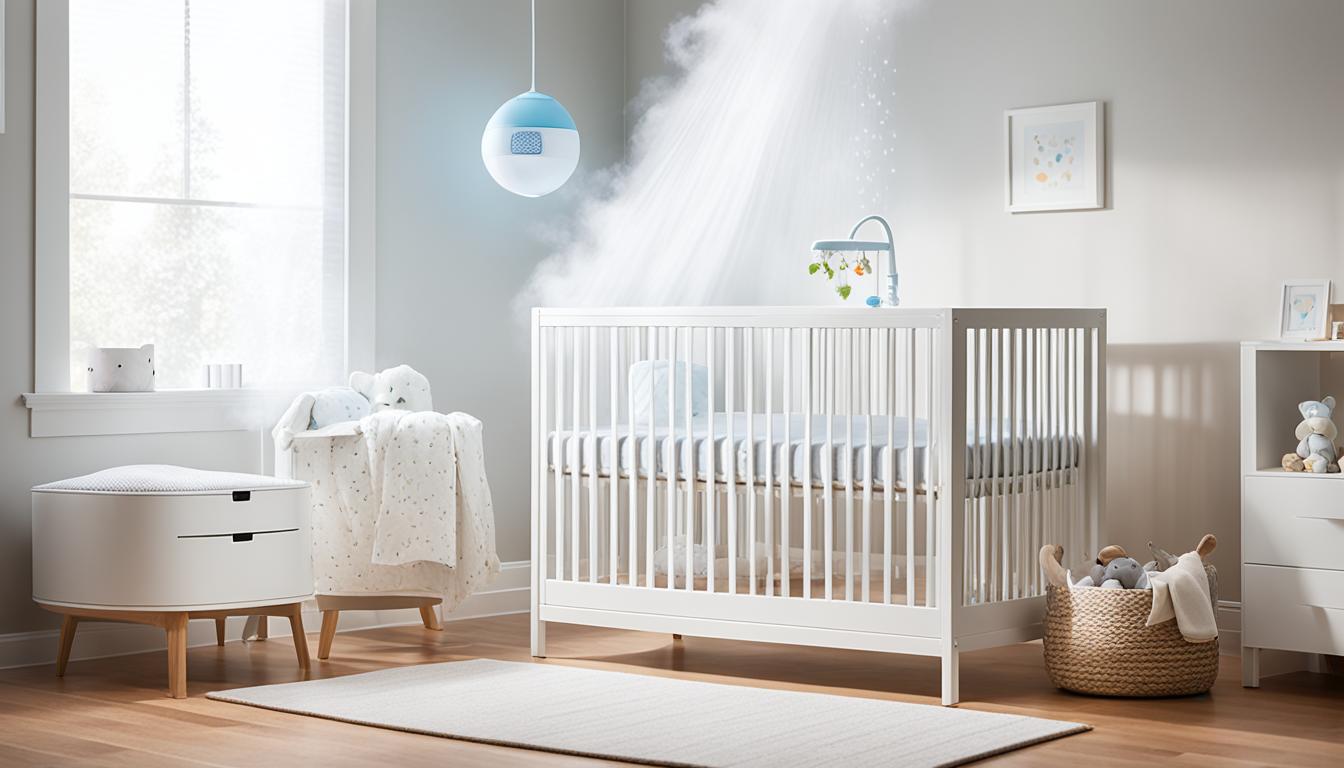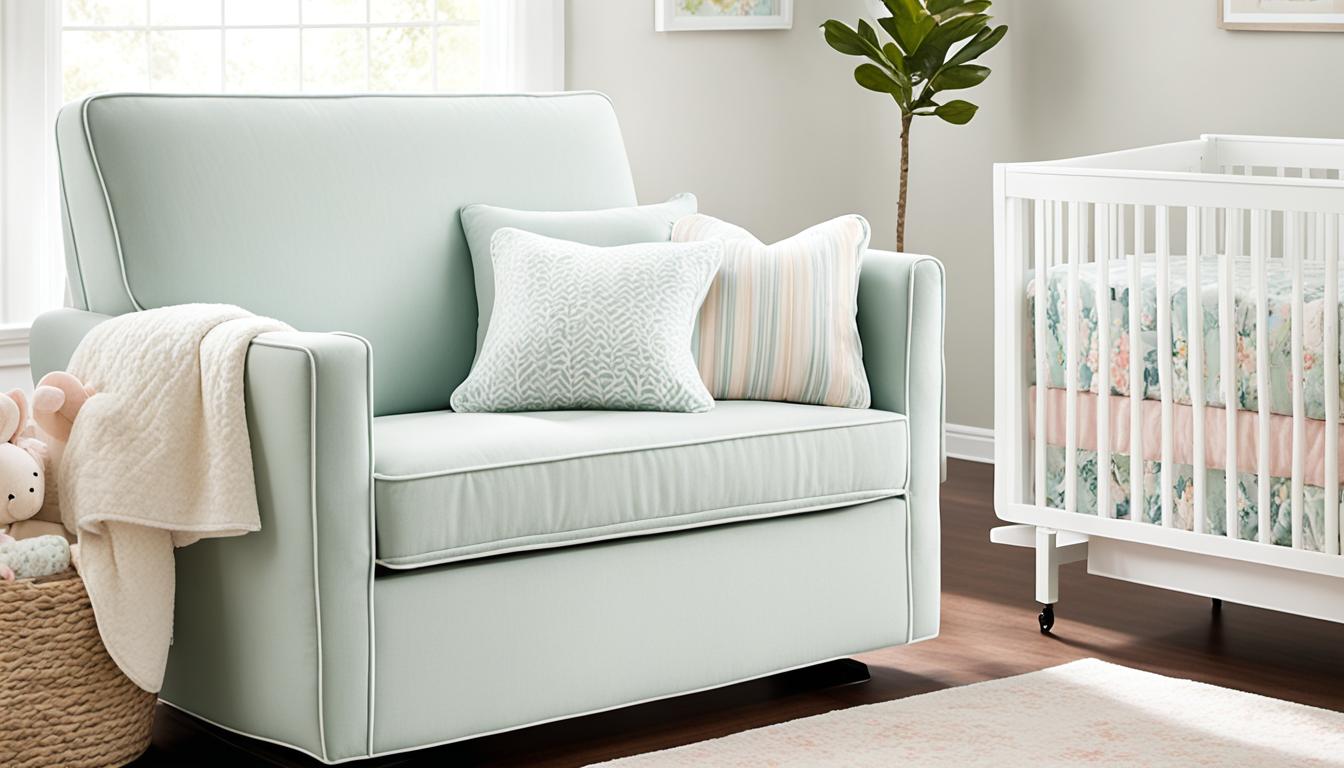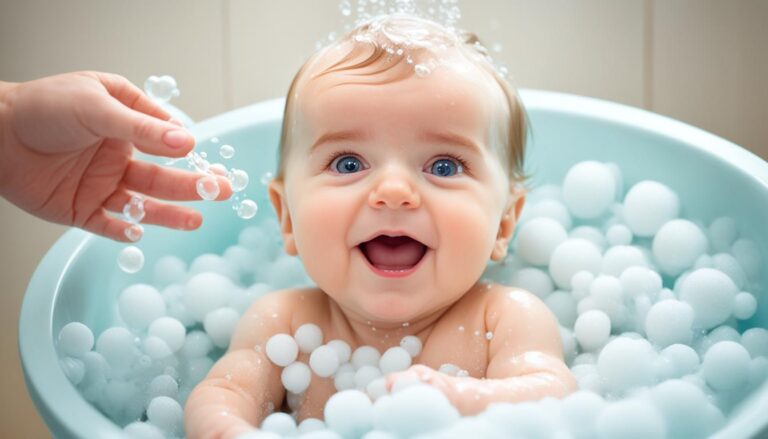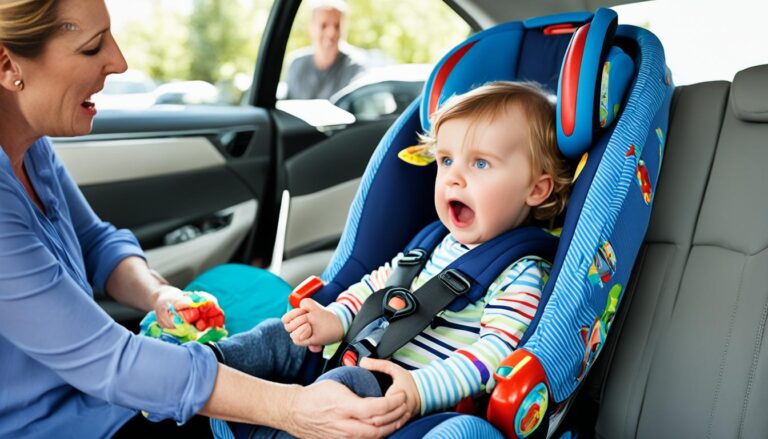How Close Should Humidifier Be To Baby
How close should the humidifier be to your baby? It is recommended to place the humidifier about 3 feet away from the baby’s crib.
This distance helps prevent excessive exposure to moisture, avoiding the risk of damp bedding, pillows, and stuffed animals, which can lead to mold and bacteria growth.
However, the placement of the humidifier is just one factor to consider. You should also think about ensuring proper airflow throughout the room, keeping the humidifier away from the sleeping area to prevent excessive humidity, and ensuring its safety by avoiding tripping hazards or the humidifier falling into the crib.
Key Takeaways:
- Place the humidifier about 3 feet away from the baby’s crib to prevent excessive exposure to moisture.
- Ensure proper airflow throughout the room to promote even distribution of humidity.
- Keep the humidifier away from the sleeping area to avoid excessive humidity.
- Avoid tripping hazards or the humidifier falling into the crib to ensure safety.
- Consider the overall nursery setup to create a comfortable and safe environment for your baby.
Airflow and Moisture Distribution
Proper airflow is crucial for ensuring the effective use of a humidifier in your baby’s nursery. By understanding the importance of airflow and implementing the right strategies, you can achieve proper moisture distribution throughout the room, creating a comfortable environment for your little one.
Positioning for Even Moisture Distribution
When it comes to positioning the humidifier, opting for a central location within the nursery is key. Placing the humidifier in the center ensures that the moisture is evenly dispersed throughout the room, allowing your baby to benefit from the humidifier’s effects no matter where they are. Avoid placing the humidifier in a corner, as this can lead to the concentration of moisture in one area, leaving other parts of the room unaffected.
Promoting Airflow Efficiency
Ensuring proper airflow in the nursery is essential for maximizing the benefits of the humidifier. Arrange the furniture and other nursery accessories in a way that allows air to circulate freely, preventing stagnant air pockets. This helps distribute the moisture evenly and prevents the excessive concentration of moisture in certain areas. Additionally, keep the humidifier away from obstructions such as curtains or furniture that may obstruct airflow.
Creating a Comfortable Nursery Environment
In addition to proper moisture distribution, it’s important to consider other factors that contribute to a comfortable nursery environment. Keep the humidifier away from the immediate vicinity of the baby’s crib to avoid direct mist exposure. This helps maintain a safe and optimal level of humidity for your baby. It’s also important to ensure that the humidifier is situated on a stable surface, away from any potential tripping hazards or the risk of it falling into the crib.
A Visual Representation of Proper Airflow and Moisture Distribution
To give you a better understanding, here is an illustrative table showcasing the benefits of central placement for the baby humidifier:
| Proper Moisture Distribution Benefits | Concentration of Moisture in a Corner |
|---|---|
|
|
Now that you understand the importance of proper airflow and moisture distribution, you can ensure that your baby experiences the full benefits of a well-placed humidifier.
Safety Considerations
Safety should always be a top priority when using a humidifier in your baby’s nursery. Even if you opt for a cool mist humidifier, it’s important to place it in a location where the cord cannot become a tripping hazard or fall into the crib. Babies are curious and can accidentally pull a humidifier onto themselves if the cord is within their reach. To prevent this, ensure that the humidifier is on a stable surface that is well out of your baby’s reach.
Additionally, keep in mind the mist style of the humidifier. Pediatricians generally recommend cool mist humidifiers for nurseries, as they don’t pose a burn hazard like warm mist humidifiers or vaporizers. An even safer option is a clean moisture humidifier that uses evaporative mist technology, eliminating the risk of water damage, wet bedding, mold, or bacteria.
| Humidifier Type | Safety Features |
|---|---|
| Cool Mist Humidifier | – No burn hazard – Suitable for nurseries – Recommended by pediatricians |
| Clean Moisture Humidifier | – Evaporative mist technology – Eliminates water damage and mold – Safe for baby’s room |
Note: Always refer to the manufacturer’s guidelines and instructions for specific safety considerations related to your chosen humidifier model.
Benefits of Using a Humidifier for Babies
Using a humidifier in your baby’s nursery offers numerous benefits for their health and well-being. Let’s explore some of the advantages:
Nasal Congestion Relief
Babies often struggle with nasal congestion due to their delicate nasal passages. A humidifier can provide relief by moisturizing the air, reducing inflammation, and making it easier for your little one to breathe. Say goodbye to stuffy noses and hello to better sleep for both you and your baby.
Dry Skin Prevention
Dry skin and eczema are common concerns for babies. By maintaining proper moisture levels in the air, a humidifier can help keep your baby’s skin hydrated and reduce irritation. It acts as a natural moisturizer, preventing dryness and promoting healthier skin.
Reducing Illness Risks
A humidifier can create an environment that is less favorable for airborne viruses and bacteria. Studies have shown that elevated humidity can lower the survival rate of pathogens and boost the body’s immune response. By using a humidifier, you can help reduce the risk of your baby falling ill.
Improving Sleep
A well-rested baby is a happy baby. A humidifier can promote better sleep by creating a soothing white noise and offering optional aromatherapy features. The calming sounds and gentle scents can help create a peaceful sleep environment, ensuring your baby gets the rest they need.
Investing in a high-quality humidifier for your baby’s nursery is a decision that can lead to multiple benefits. From relieving nasal congestion to preventing dry skin and reducing illness risks, a humidifier can make a significant difference in your baby’s health and sleep quality. So give your little one the gift of comfort and well-being with a reliable humidifier.
How to Choose the Right Humidifier for Your Baby
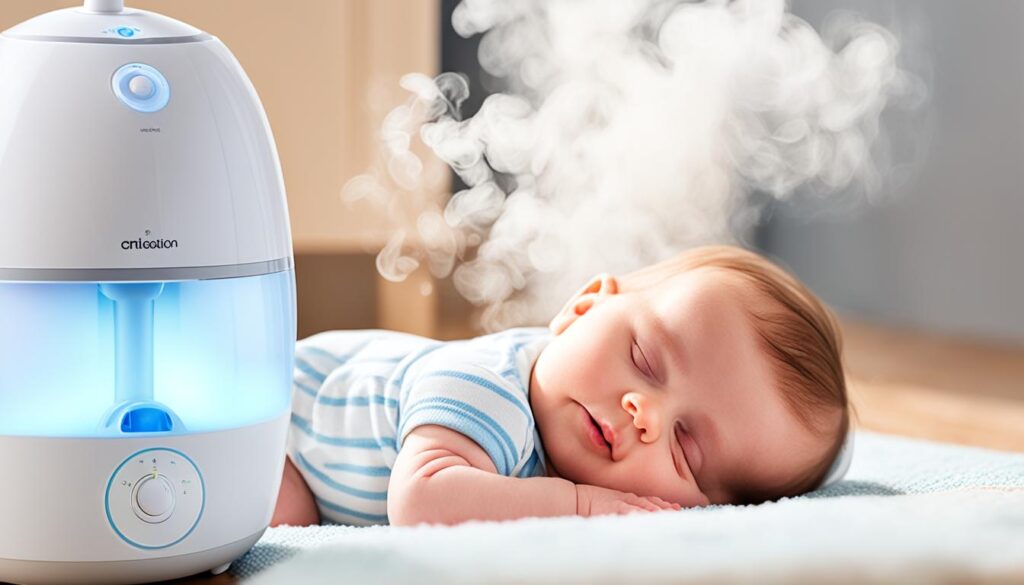
Selecting the right humidifier for your baby is crucial to ensure their safety and comfort. With numerous options available in the market, it’s important to consider specific factors that will meet your baby’s needs.
Cool Mist vs Warm Mist Humidifier
When choosing a humidifier for your baby’s nursery, it’s recommended to opt for a cool mist model. Cool mist humidifiers are generally safer as they do not pose a burn hazard compared to warm mist humidifiers or vaporizers. Pediatricians commonly recommend cool mist humidifiers for nurseries to avoid any potential risks.
A cool mist humidifier works by using impeller or ultrasonic technology to disperse cool moisture into the air. It can help alleviate nasal congestion, ease dry skin, and create a comfortable environment for your little one to breathe easily.
On the other hand, warm mist humidifiers boil water to produce warm steam, which can be a risk for accidental burns, especially in a nursery setting. Although warm mist humidifiers can provide some benefits, the potential risks associated with them make cool mist humidifiers the safer option for your baby.
Easy Maintenance and Safety Features
Another important factor to consider when choosing a baby humidifier is ease of maintenance. Look for models with dishwasher-safe components, making it convenient for you to clean and sanitize the humidifier regularly. Disposable paper filters can also be beneficial in eliminating contaminants and ensuring clean and safe moisture distribution.
Safety features are equally crucial when selecting a humidifier for your baby’s nursery. Look for humidifiers that have an automated shut-off function when the water tank is empty. This feature ensures that the humidifier does not continue running without water, preventing any potential damage or risks.
Additionally, consider the stability of the humidifier. Choose a model that will sit securely on a stable surface, reducing the risk of accidental tipping over, especially if your baby becomes more mobile.
Comparison Table: Cool Mist vs Warm Mist Humidifier Features
| Features | Cool Mist Humidifier | Warm Mist Humidifier |
|---|---|---|
| Burn Hazard | No | Potential risk |
| Recommended for Nurseries | Yes | No |
| Easy Maintenance | Yes | No |
| Dishwasher-Safe Components | Yes | No |
| Disposable Paper Filters | Yes | No |
| Automated Shut-Off | Yes | No |
Based on the comparison table, a cool mist humidifier offers several advantages over a warm mist humidifier, including decreased burn hazards, ease of maintenance, and safety features that promote peace of mind.
By carefully considering these factors, you can choose a humidifier that best suits your baby’s needs and provides a safe and effective solution for their nursery environment.
Tips for Using a Humidifier Safely

To use a humidifier safely in your baby’s nursery, it’s important to follow some essential tips. Routine maintenance is crucial to prevent mold and mildew growth, which can be harmful to your baby’s health. Take apart the humidifier regularly, clean the basin, and maintain the filters according to the manufacturer’s instructions. Using distilled water instead of tap water is also recommended, as it reduces the risk of mineral deposits and the growth of bacteria and mold. Additionally, it’s important to monitor the humidity levels in the room and ensure that it doesn’t become excessively damp. Keeping the room properly humidified without excessive moisture is key to creating a safe and comfortable environment for your baby.
Humidifier Safety Tips:
- Regularly clean and maintain your humidifier according to the manufacturer’s instructions.
- Take apart the humidifier and clean the basin to prevent mold and mildew growth.
- Use distilled water instead of tap water to reduce the risk of mineral deposits and bacterial growth.
- Monitor the humidity levels in the room to prevent excessive dampness.
- Avoid placing the humidifier too close to the baby’s crib to prevent direct mist exposure.
Proper maintenance and monitoring of humidity levels are essential to ensure the safe and effective use of a humidifier in your baby’s nursery. By following these tips, you can create a healthy and comfortable environment for your little one.”
Recommended Practices for Humidifier Use
Following recommended practices for using a humidifier in your baby’s nursery can help ensure optimal results. It is generally safe to run the humidifier all night, as long as you monitor the room humidity and avoid excessive dampness.
Best Practice #1: Running the Humidifier All Night
Running the humidifier all night can provide continuous moisture and benefits for your baby’s comfort and health. However, it’s important to keep an eye on the humidity levels to avoid excessive moisture in the room. Use a hygrometer to monitor the humidity and aim for a level between 30% and 50% for optimal results.
Best Practice #2: Avoiding Essential Oils
While essential oils may have their benefits, it’s generally recommended to avoid using them in the baby’s nursery humidifier. Essential oils can potentially pose risks for babies, including respiratory irritation and allergic reactions. It’s best to prioritize clean and pure humidification without any added fragrances or oils.
Best Practice #3: Proper Placement
Proper placement of the humidifier is crucial to maximize its effectiveness while ensuring your baby’s safety. Position the humidifier at least 6 feet away from the baby’s crib to prevent direct mist exposure. This distance allows the moisture to disperse evenly throughout the room. It’s also essential to securely tuck away the cord to eliminate any potential tripping hazards.
Implementing these best practices can help you create a safe and comfortable environment for your baby. By running the humidifier all night, avoiding essential oils, and ensuring proper placement, you can provide optimal humidity levels for your little one’s health and well-being.
Choosing the Best Humidifier for Your Baby
When it comes to selecting the best humidifier for your baby, the Canopy Nursery Humidifier is the top choice. It offers clean hydration benefits, ensuring that your little one breathes in fresh and healthy air. Canopy humidifiers utilize innovative evaporative mist technology and disposable paper filters to eliminate contaminants, providing mold-free moisture for your baby’s nursery.
One of the key advantages of the Canopy Nursery Humidifier is its easy maintenance. The dishwasher-safe components make it convenient for busy parents to keep the humidifier clean and functioning optimally. With Canopy, you can have peace of mind knowing that your baby’s humidifier is providing clean and hygienic moisture without any hassle.
In addition to its clean hydration benefits, Canopy offers a range of other features to enhance the nursery environment. They provide scent subscriptions and accessories, allowing you to customize the ambiance of your baby’s room. By choosing Canopy, you can create a soothing and comfortable atmosphere that promotes better sleep, congestion relief, and overall well-being for your baby.
FAQ
How close should a humidifier be to a baby?
It is recommended to place the humidifier about 3 feet away from the baby’s crib to avoid excessive exposure to moisture.
What should I consider when placing the humidifier in my baby’s nursery?
Ensure proper airflow throughout the room by placing the humidifier in a central location. Avoid corners to prevent moisture concentration in one spot.
What safety precautions should I take when using a humidifier for my baby?
Place the humidifier on a stable surface, well out of your baby’s reach, and ensure the cord is not a tripping hazard. Opt for a cool mist humidifier to avoid burn hazards.
What are the benefits of using a humidifier for babies?
Using a humidifier can alleviate nasal congestion, prevent dry skin, reduce illness risks, and improve sleep for your baby.
How do I choose the right humidifier for my baby?
Opt for a cool mist humidifier with easy maintenance and safety features, such as automated shut-off when the tank is empty.
Any tips for using a humidifier safely in my baby’s nursery?
Regularly clean and maintain the humidifier to prevent mold and mildew. Use distilled water, monitor humidity levels, and avoid excessive moisture.
What are the recommended practices for using a humidifier in my baby’s nursery?
It is generally safe to run the humidifier all night, as long as you monitor the room humidity and avoid using essential oils. Position the humidifier at least 6 feet away from the baby’s crib to prevent direct mist exposure.
What is the best humidifier for my baby?
Consider the Canopy Nursery Humidifier, which offers clean hydration benefits, mold-free technology, and easy maintenance.

